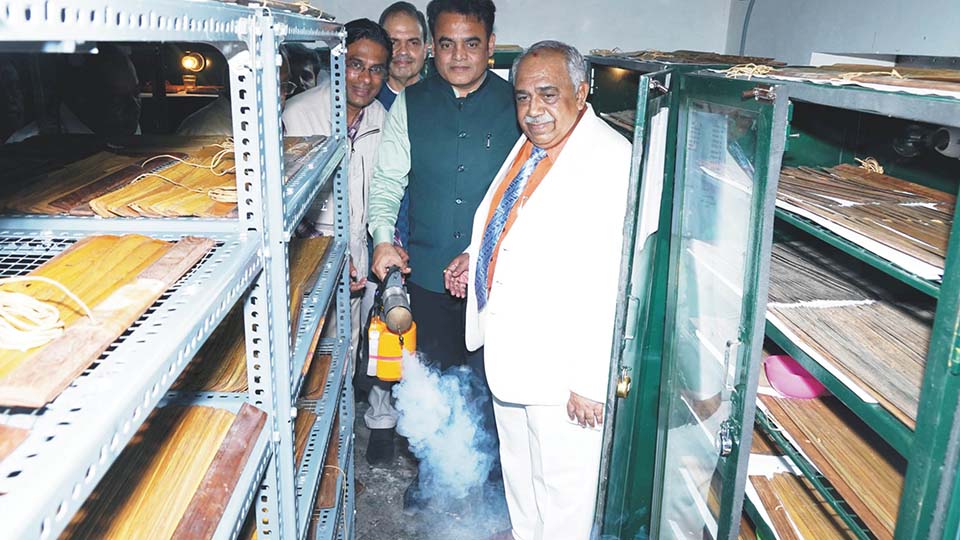Mysuru: A full-fledged Fumigation Chamber to conserve rare palm-leaf manuscripts at the Oriental Research Institute (ORI) was inaugurated by the Minister for Higher Education, IT and BT Dr. C.N. Ashwathnarayan yesterday.
ORI, established 130 years ago, is a repository of thousands of manuscripts that date back to more than 700 years in languages including Sanskrit, Kannada, Tamil and Telugu. It also has 41,000 rare printed and other types of manuscripts. The manuscripts include the rarest and a complete treatise of Kautilya’s Arthashastra.
These manuscripts of ancient and mediaeval India are preserved by way of literary works and treatise on various subjects. University of Mysore (UoM) has signed an MoU (Memorandum of Understanding) with Bengaluru’s Mythic Society for digitisation of manuscripts.
Normally chemical treatments are given using Fumigation Chambers to protect palm-leaves from white ants, fungus and other insects. Dried and powdered leaves of Aswagandha in small packets are kept with the manuscripts covered in clothes to repel insect attack.

Knowledge at fingertips
Impressed with the collection of manuscripts, Dr. Ashwathnarayan said that a slice of Indian heritage is available in the manuscripts collected at the ORI over several decades. “I appreciate the ongoing efforts in conservation and digitisation and once the project is complete, the knowledge and ancient Indian wisdom enshrined in the manuscripts would be easily available to scholars for research. This would add to the knowledge base,” he added.
As per the project specifications, the palm-leaf manuscripts will be cleaned and a regular process for cleaning and preserving them will be put in place while the catalogue of titles that include palm leaf manuscripts, handwritten works and collection of printed works will be made available to the public.
Also, all the palm leaf works and books will be image-scanned and preserved in a safe place, while the images will be put for crowd-sourced text digitisation. The first phase entailing cleansing and conservation will take two years after which the scanning, digitisation and hosting a website will be taken up in a phase-wise manner, the Minister was told by UoM Vice-Chancellor Prof. G. Hemantha Kumar.

Process ensures longevity
The manuscripts are first cleaned with brushes and placed in a fumigation chamber to improve longevity of these manuscripts. For fumigation, the manuscripts will be placed inside the Fumigation Chamber to make them free from dust and termites.
At one time, around 20-25 manuscripts could be fumigated. With this simple technology, these manuscripts may be preserved for another 400-500 years. After the cleaning process, lemon grass oil is applied to the fumigated manuscripts and dried for some time.
The Minister was told that the next process involves wrapping the manuscripts in a red cotton cloth before digitisation. After the manuscripts dry following lemon grass oil application, starch content is completely removed from the red cloth to ensure that there is no moisture.
As part of the digitisation, the manuscripts will be image-scanned. Palm leaf works will be identified and their Unicode digitisation will be undertaken with the help of manuscript readers. The scanned copies are then converted to formats including PDF, jpeg and PNG and uploaded on the website that will be the exclusive property of the ORI, the Minister was told.
Chief Minister’s e-administration advisor Belur Sudarshan, Mythic Society Honorary Secretary V. Nagaraj, ORI Director Dr. Ramapriya and Registrar Prof. R. Shivappa were present.








Recent Comments